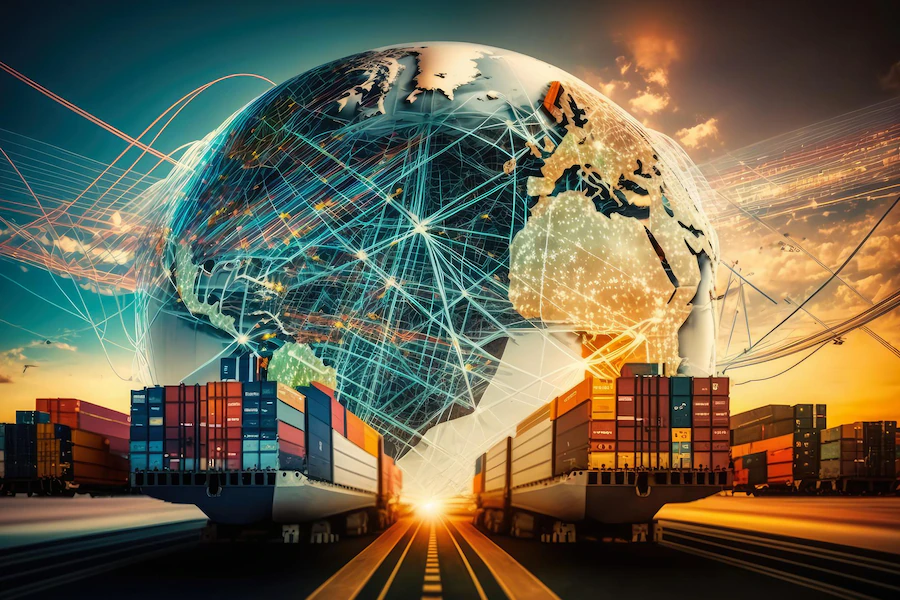Navigating The Supply Chain Maze: The Ripple Effect On Futures And Commodities

Climate change, labor shortages, inflation, economic stability, and shortage of raw materials, among other disruptions, have made supply chain management and procurement more complex. It is the supply chain maze and its bottlenecks that we need to overcome.
This pressure has forced procurement and sourcing leaders to continue adjusting their strategies to minimize risk exposure, address the needs of shareholders, improve customer experience, and control spending.
However, according to experts at Global Consulting, the key to overcoming such challenges lies in getting accurate and timely supplier insights.
Challenges & Their Ripple Impacts On Supply Chain Procurement
Supply chains globally consist of various businesses, including merchants, distributors, warehousing, freight forwarders, suppliers, and manufacturers. These businesses help to move information and resources globally. They span different countries and continents, generally leveraging low production, commodity, and labor costs.
Organizations that are looking to take advantage of the global supply chain’s benefits should overcome a couple of hurdles, most of which are complicated, including:
- Defects and quality control: Quality issues can sometimes be hard to manage. For instance, businesses should consider variance in an acceptable defect level among different countries.
- More lead time: Buyers increasingly demand faster deliveries. The expectations have increased, thanks to technological advancements in eCommerce.
- Cash flow management: Cash flow management is a critical matter in businesses, but it is difficult in supply chain management and logistics.
However, there are many other reasons that can make navigating the supply chain maze more difficult for you.
Underestimating Consumer Demand Recovery In This Age Of Instant Gratification
It is the age of instant gratification, giving businesses very little scope to underestimate the demand recovery of consumers. In April 2024, the National Retail Federation announced a tentative growth of retail sales between 2.5% and 3.5%, which is between $5.23 trillion and $5.28 trillion.
The report further says,
“Consumers’ behavior and spending power are tied to their financial health, and the consumer sector looks good at the moment. Consumer spending on goods and services has eased recently but continued to have positive momentum at the beginning of the year. We expect inflation-adjusted consumer spending will likely grow around 2%, compared with 2.3% in 2023.”
So, to navigate the supply chain maze, you have proper insights and the logistics to keep your supply chain functioning in the desired way.
Not Having Diversified Suppliers
The absence of diversified vendors can create bottlenecks in navigating the supply chain maze. You cannot always have control over climatic issues, political unrest, or other geographical problems. For instance, the Israel-Palestine conflict has created major bottlenecks in Container Shipping through the Suez Canal and the Strait of Hormuz.
So, you must diversify your vendors so that you do not need to collect all the eggs from a particular geographical basket. It is also a smart trick to build a business’s supply chain resiliency.
The Effect Of Shift In The Supply Curve

A change in the supply chain may have an effect on procurement. When the curve changes, the supply or demand for services and goods has also changed. This change may impact pricing for certain services and products, causing fluctuations, that procurement teams must be aware of.
Procurement teams should stay updated with those changes to secure good deals for their businesses. They should also prepare to adjust strategies to remain competitive.
The best way a procurement team may navigate the ripple impact in the supply chain is to diversify their customer base. By working with different suppliers for different services and goods, your business will mitigate the risks associated with fluctuation that market changes cause.
Another important aspect is to maintain a solid relationship with your suppliers. A good relationship established on an open communication channel fosters collaboration between suppliers and organizations. This helps to build resilience against sudden shocks that shifting supply curves cause.
Understanding how changes in the supply chain impact procurement allow businesses to take steps toward mitigating risks and staying competitive during market fluctuations.
Related: Navigating Supply Chain Risks: 4 Strategies And Solutions
What Is The Way Forward?
While the effect of inflation on the future and commodity pricing seems complex, there are steps you may take to mitigate those effects.
One step you can take is to get government support. Your government must prioritize investments in commodities even during economic challenges. Other solutions may include the following:
- Continued innovation
- Awareness and education
- Technology optimization
The supply chain processes are both exhilarating and challenging, allowing experts to overcome obstacles and innovate. Businesses can navigate supply chain complexities and turn them into success and growth opportunities by optimizing processes, quantifying uncertainty, scaling operations efficiently, and addressing customers’ expectations.
Can AI Make Navigating The Supply Chain Maze Easy?

End-to-end traceability is most important if you want to navigate the supply chain maze without bottlenecks. AI can surely help in this regard and make the process of supply chain management more integrated.
Further, with better traceability or real-time item-level visibility, AI can help you make the best decisions.
Let’s understand how AI can ensure end-to-end traceability in the supply chain maze and how it can help the decision-making process.
AI Ensuring End-To-End Traceability In Item-Level Movement
From standardizing and securing data to collaborating with suppliers and integrating the systems, AI has versatile roles to play in improving supply chain management.
Standardizing And Securing Data
Stakeholders can easily exchange information when the protocols and formats of data are standardized. Further, AI today can handle the most complex security protocols, ensuring the safety of your data from cyber threats. AI also works to protect data from unauthorized access.
Integrating Different Systems For Interoperability
To improve the visibility and efficiency of supply chain management, AI can help the integration of different systems. Integration of various systems and technologies is crucial for real-time data sharing and a collaborative process.
Collaborating With Suppliers
AI helps in gathering and storing accurate information from suppliers to know the origin and movement of the materials.
AI Helping Your Decision-Making Process
With predictive analysis and proper risk assessment, AI can help you navigate the supply chain maze with a better decision-making process.
The predictive analytics of AI assess a vast amount of historical records and data. It is essential for:
- Identifying patterns of demand and fluctuations
- Making predictions about tentative demands
- Highlighting possible disruptions in the near future
The prescriptive insights of AI can optimize a business’s inventory by helping it find the most cost-effective vendors. These insights are further collected from various sources.
Further, the optimization tools with AI can adopt different parameters of supply chain management. This is crucial for responding to problems like transportation issues or supply crunch quickly.
Finally, AI tools can predict different risk factors in the supply chain maze so that you can have the right resources and means to mitigate the problems.
Final Words
There can be bottlenecks like cash flow management and a lack of diversified suppliers while navigating the supply chain maze. However, with the integration of AI, a business can ensure end-to-end visibility in an item-level movement.
What do you think of integrating AI into supply chain management? Don’t forget to share your insights with us.
Read Also:

























Leave A Reply